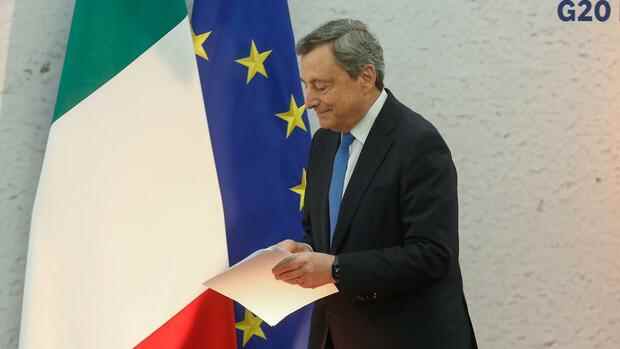He still has a lot of construction sites ahead of him.
(Photo: ROPI)
Rome They wanted to paralyze the whole country, block ports and local public transport. In the end, the results of the “Green Pass” opponents are quite sobering: Day one of the 3G obligation at work, which has been in force in Italy for 23 million employees and civil servants since Friday, went almost without a hitch. There were demonstrations in the big cities. In Trieste, for example, 6,000 people gathered in front of the container port – but operations just continued.
For Mario Draghi this is a point win. The majority of Italians support their prime minister, who since taking office in February has relied heavily on vaccinations and reforms to lead the country out of the crisis.
Even in his broad coalition from left to right, which has 85 percent of the vote in parliament, there have always been critical voices. But Draghi was not deterred, stuck to his hard line.
For the prime minister, the “Green Pass” is an “instrument of freedom and security”. Evidence of vaccination, recovery or a fresh corona test has been needed since August, who wants to eat inside restaurants, who wants to go to the cinema or museum.
Top jobs of the day
Find the best jobs now and
be notified by email.
Since September, at the start of school and semester, the green certificate has been mandatory for all employees in the education sector, and it is valid on all long-distance trains. The seven-day incidence has fallen since then and is now consistently below 30. At the same time, the rate of fully vaccinated people over twelve years has increased to more than 81 percent.
Italy’s 3G obligation in the world of work is unique in Europe
But that’s not enough for Draghi. The 74-year-old wants to reach 90 percent before winter. Hence the expansion to the entire world of work, which is unparalleled in Europe: Those who fail to provide evidence will be suspended without a salary.
Critics see in Draghi’s course a compulsory vaccination through the back door. Corona tests cost 15 euros in Italy. The unions had tried to pass the costs on to the companies – without success. For Draghi, the incentive to vaccinate would have ceased to exist.
A week ago, a mob of anti-vaccination campaigners and radicals, led by the right-wing extremist Forza Nuova party, roamed Rome and devastated the headquarters of the CGIL trade union. Draghi was shocked by the violence and showed solidarity with the association. He will have liked the fact that tens of thousands of people from all over the country gathered a week later to demonstrate against fascism.
In any case, the prime minister can look back on successful months: He has initiated a reform of the judicial system that is long overdue and is intended to accelerate the processes. A reform to modernize the encrusted administration has also been passed. Companies in the country are more optimistic than they have been in a long time, industrial production is picking up and the number of unemployed is falling.
Internationally, Italy has regained reputation and credibility thanks to the former ECB head at the top. The G20 special summit last week showed that Draghi can also do global politics: At his request, the heads of state and government met to coordinate humanitarian aid for Afghanistan.
In Italy they are already talking about the new strong duo at the top of the EU: “Dracron”. Almost ostentatiously, Draghi and French President Emmanuel Macron dined in a luxury restaurant in Marseille in September to celebrate the Italian’s birthday.
Italy’s economy is expected to grow by more than six percent
The rest of Europe is currently looking somewhat disbelievingly at Italy, which is running away from the other large countries in terms of economic growth – with stable inflation figures at the same time. The gross domestic product is expected to grow by more than six percent this year, and next year Italy will be in a better position than before the pandemic.
What is often ignored here: The country comes from a deep valley, even ten years after the financial crisis, the economy is not yet back to the level it was then. And: No country in Europe has piled up so many debts.
There are still a lot of construction sites for Draghi: At 49 percent, female employment is lower than in any other industrialized country, families are not given enough support, and the pension and tax system urgently needs to be reformed. And Draghi has to ensure that the 191 billion euros from the EU reconstruction fund are invested in sensible future projects – and that they do not perish in the bureaucracy or even end up in the hands of the mafia.
Political stability is also crucial for this. Will Draghi be able to hold the government together until the end of the legislature in 2023 – or even beyond? A new president will be elected in spring 2022. Above all, the right-wing parties would like to nudge Draghi into the representative office in order to then take over the government himself through early elections. Even if the country’s success is currently in his hands: Draghi has not yet commented on his personal future.
More: Demos and strikes – is Italy threatened with a logistics collapse?
